UPDATE for May 5, 2024: Another X flare and 2 almost Xs
Update: X flare! Another one from AR3663 came shortly after our 24-hour observation period ended at 11:41 UTC. AR3663 is really going strong. It could be an exciting day.
? ? ? ? ? X flare! AR3663 is at it again! It just keeps on flaring. What’s next?
MORE at EarthSky: https://t.co/xD29wLfm4e pic.twitter.com/xVTWUb2A56
— Dr. C. Alex Young (@TheSunToday) May 5, 2024
Sun news for May 5, 2024: Pow, pow, pow! X flare and several almost-X flares
? ? Sun news for May 5, 2024: Pow, pow, pow! X flare and several almost-X flares
? ? ? X flare! AR3663 just can’t stop the flaring. In addition to the X flare, the region produced two almost-X flares, an M9.0 and an M8.4.
? MORE at EarthSky: https://t.co/xD29wLfm4e pic.twitter.com/vhqwJM1DAL
— Dr. C. Alex Young (@TheSunToday) May 5, 2024
Today’s top story: X flare! AR3663 just can’t stop the flaring. In addition to the X flare, the region produced two almost-X flares, an M9.0 and an M8.4. The region produced all but one of the flares during the observation period: one X, six M, and 14 C flares. The region is very magnetically complex, beta-gamma-delta, which is consistent with the region’s activity. The other region with complexity, beta-delta, is AR3664, which produced one of the period’s M flares. Both regions have continued some minor growth in size, with AR3663 being the size of 3.5 Earths and AR3664 being the size of 2.4 Earths. Several coronal mass ejections (CMEs) associated with these various eruptions blasted out from the sun during the observation period. At the moment, we do not have enough imagery to determine the trajectory of these eruptions. A CME that left the sun during an C3.9 flare on May 3 will glance Earth on May 6. Keep up the excitement, AR3663! Stay tuned for more news.
Last 24 hours: Sun activity is high during the past day with the production of an X flare and seven M flares. Between 11 UTC yesterday and 11 UTC today, the sun produced 22 flares: one X flare, seven M flares, and 14 C flares. The largest event of the period was an X1.3 flare at 5:47 UTC on May 5 from AR3663. The X and M flares of the period:
– M1.3 flare by AR3663 at 18:10 UTC on May 4. R1 (minor) radio blackout over North America.
– M3.3 flare by AR3663 at 22:23 UTC on May 4. R1 (minor) radio blackout over the Pacific Ocean.
– M9.0 flare by AR3663 at 23:28 UTC on May 4. R2 (moderate) radio blackout over the Pacific Ocean.
– M8.4 flare by AR3663 at 1:15 UTC on May 5. R2 (moderate) radio blackout over the Pacific Ocean.
– X1.3 flare by AR3663 at 5:47 UTC on May 5. R3 (strong) radio blackout over Asia (the largest blackout)
– M1.3 flare by AR3663 at 8:07 UTC on May 5. R1 (minor) radio blackout over the Middle East.
– M2.4 flare by AR3664 at 9:23 UTC on May 5. R1 (minor) radio blackout over Africa.
– M7.5 flare by AR3663 at 9:53 UTC on May 4. R2 (moderate) radio blackout over Africa.
The lead flare producer of the period was active region AR3663, which produced 21 flares: an X flare, six M flares, and 14 C flares. The sun has seven labeled regions on its Earth-facing side, including newcomer AR3667.
Next 24 hours: The chance for C flares is 99%. The chance for M flares is 75%. The chance for an X flare is 25%.
Next expected CME: The current period has a lot of activity that has not been fully sorted out. The two M9 flares and the M8.4 flares may have coronal mass ejections (CMEs) associated with them. The same is true for the several smaller flares but there is not enough coronagraph imagery to finalize the analyses. A glancing blow from the CME associated with the C3.9 flare at 20:37 UTC on May 3 is expected to reach Earth on May 9. No other Earth-directed CMEs have been observed in coronagraph imagery.
Current geomagnetic activity: Earth’s magnetic field is quiet at the time of this writing (11 UTC on May 5). Periods of G1 (minor) geomagnetic storms are likely on May 5 due to high-speed solar wind from coronal holes and the anticipated arrival of the May 3 CME late in the day. Periods of G1-G2 (minor-moderate) geomagnetic storms are likely on May 6 due to continued CME activity and coronal hole influences. Active conditions are likely on May 7, with the expected onset of another coronal hole.

Sun news for May 4, 2024: Almost-X flare! And sun-stuff headed to Earth
? ? Sun news for May 4, 2024: Almost X flare and sun stuff headed to Earth
? ? ? Yesterday’s X1.7 flare produced a CME and after analysis, was determined to be Earth-directed.
? ? The sun stayed at a high activity level.
? MORE at EarthSky: https://t.co/xD29wLfm4e pic.twitter.com/NwVFClqsb8
— Dr. C. Alex Young (@TheSunToday) May 4, 2024
Today’s top story: Yesterday’s X1.7 flare produced a coronal mass ejection (CME). Now, modeling and analysis shows a component is Earth-bound. The sun-stuff should arrive late May 5 to early May 6. We have the possibility for a G1(minor) to a G2 (moderate) geomagnetic storm. And that means auroras! Over the past day, the sun stayed at a high activity level, producing an almost-X flare. Active region AR3663 produced an M9.1 flare at 6:19 UTC on May 4. This sunspot region kept flaring all day, releasing four Ms and eight C flares for a total of 13 flares during our observation period.
Last 24 hours: Sun activity is high during the past day with the production of an almost-X flare and six M flares in total. Between 11 UTC yesterday and 11 UTC today, the sun released 20 flares: six M flares and 14 C flares. On May 4, at 6:19 UTC, active region AR3663 in the northwest produced an M9.1 flare, which was the largest event. Shortly after the flare, an R2 (moderate) radio blackout affected an area over the Bay of Bengal. The M flares of the period:
M1.2 flare by AR3654 at 22:47 UTC on May 3. R1 (minor) radio blackout on the Pacific Ocean over Hawaii.
M1.1 flare by AR3663 at 23:16 UTC on May 3. R1 (minor) radio blackout on the Pacific Ocean west of Hawaii.
M2.4 flare by AR3663 at 23:30 UTC on May 3. R1 (minor) radio blackout on the Pacific Ocean west of Hawaii.
M1.6 flare by AR3663 at 0:36 UTC on May 4. R1 (minor) radio blackout on the west Pacific Ocean.
M9.1 flare by AR3663 at 6:19 UTC on May 4. R2 (moderate) radio blackout over the Bay of Bengal. (The largest)
M1.5 flare by AR3663 at 7:07 UTC on May 4. R1 (minor) radio blackout over India.
The lead flare producer of the period was active region AR3663, which produced 13 flares, four M flares (the M9.1 included) and 8 C flares. The sun has six labeled regions on its Earth-facing side, including newcomer AR3666.
Next 24 hours: The chance for C flares is 99%. The chance for M flares is 75%. The chance for an X flare increased to 25%, as compared to yesterday’s 15%.
Next expected CME: Modeling and analysis of yesterday’s X1.7 event determined an associated coronal mass ejection (CME) is Earth-directed. The arrival is estimated to be late May 5 to early May 6. Two filament eruptions associated with active region AR3661 are under analysis. No other Earth-directed CMEs have been observed in coronagraph imagery.
Current geomagnetic activity: Earth’s magnetic field is quiet at the time of this writing (11 UTC on May 4). After the storm, there is calm. All perturbations calmed down to quiet levels after yesterday’s unexpected G3 (strong) geomagnetic storm. Conditions for G1 (minor) to G2 (moderate) geomagnetic storming may occur today, from late May 5 to early May 6. The coronal mass ejection (CME) that the sun launched during yesterday’s X1.7 event would be the cause of this activity. There may be the additional influence of high-speed solar wind from coronal holes. Together with this coronal mass ejection (CME), there is a good chance for auroral displays. Clear skies, aurora watchers!
Sun news for May 3, 2024: KABOOM, X flare! Big storm at Earth
The EarthSky sun news team created this 1-minute video summary for you.Kaboom! For the first time in over a month, the sun has blasted an X flare, the strongest category of solar flare. The X1.7 came from sunspot region AR3663 at 2:22 UTC on May 3. It caused a strong R3 radio blackout in an area over the Philippine Sea, south of Japan. The X flare marks a peak in the strong activity observed from this region recently; it’s been growing in size and magnetic complexity, becoming the only region to show a high potential beta-delta configuration. And it lived up to that potential! We’ve also seen excitement at Earth over the past day. An unexpected G3 (strong) geomagnetic storm started at 17:59 UTC on May 2, with the disturbance lasting for two three hour periods. Conditions for auroral displays were possible in northern latitudes as far south as Iowa and Oregon in the US. However, although some auroras were reported, the magnetic field orientation was not optimal for strong auroral activity. And on top of that, the storm occurred during the day over North America. But there’s still a chance for auroras tonight, so don’t put away those cameras …
Last 24 hours: Sun activity is high after the production of an X flare and three M flares. Between 11 UTC yesterday and 11 UTC today we saw 24 flares: an X, three M flares, and 20 C flares. The largest event was, of course, the X1.7 flare from AR3663 at 2:22 UTC on May 3. Here’s a breakdown of the past day’s major flares:
M2.8 by AR3664 at 20:57 UTC on May 2. R1 (minor) radio blackout over the Pacific Ocean east of Hawaii.
M2.7 by AR3664 at 0:15 UTC on May 3. R1 (minor) radio blackout over the Pacific Ocean west of Hawaii.
X1.7 by AR3663 at 2:22 UTC on May 3. R3 (strong) radio blackout over the Philippine Sea south of Japan.
M4.4 flare by AR3663 at 8:11 UTC on May 3. R1 (minor) radio blackout over the Arabian Sea.
The lead flare producer of the period was active region AR3663, which produced 13 flares: the X, an M, and 11 Cs. Closely behind was AR3664 in the southeast, which produced two Ms and seven C flares. The sun currently has seven labeled regions on its Earth-facing side, including newcomer AR3665.
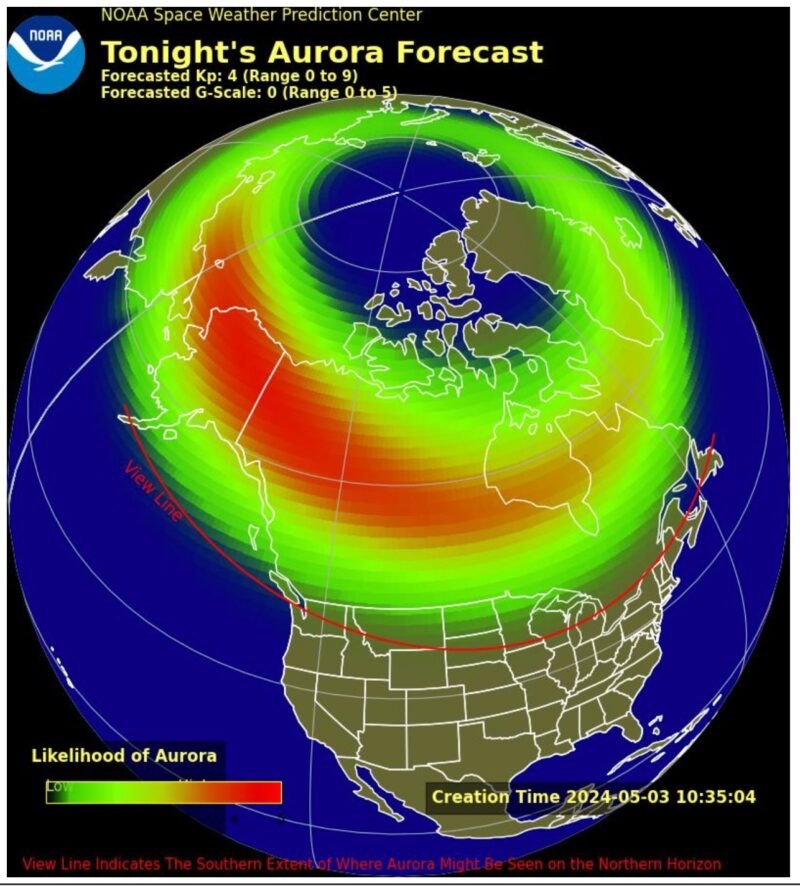
Sun news for May 2, 2024: Bye bye, AR3654
The EarthSky sun news team created this 1-minute video summary for you. Can you see the comet?Sunspot region AR3654 has really grabbed our attention during its journey across the sun’s face. After growing to be as wide as 3 Earths, it blasted an enormous almost-X flare on Tuesday night. But now its time on the Earth-facing side of the sun is coming to an end, as it starts to rotate out of view. It’s given us a parting gift, though. Shortly after the almost-X flare, it launched a huge blob of sun-stuff – a coronal mass ejection (CME) – toward Earth. This is expected to arrive on May 4, possibly causing a G1 (minor) geomagnetic storm. And that could mean auroras! Plus, although its position on the solar limb (edge) makes it hard to determine AR3654’s magnetic complexity, it does still appear to have the potential to produce some big flares. Let’s see if it’s got any final action in store for us.
Last 24 hours: Solar activity during the past day was moderate after the production of four faint M flares. Between 11 UTC yesterday to 11 UTC today, the total flare production was 17: four Ms flares and 13 C flares. The largest event was an M1.9 flare from AR3654 at 14:44 UTC on May 1. All the M flares produced R1 (minor) radio blackouts over the sun-lit Earth. Here’s a breakdown of the M flares:
M1.8 flare by AR3654 at 14:32 UTC on May 1
M1.9 flare by AR3654 at 14:44 UTC on May 1 (the largest)
M1.8 flare by AR3663 at 22:31 UTC on May 1
M1.0 flare by AR3663 at 2:17 UTC on May 2
The lead flare producer of the period was active region AR3663 in the northeast quadrant, which produced six flares: two Ms and four Cs. The sun currently has six labeled regions on its Earth-facing side, including newcomer AR3664.
Sun news for May 1, 2024: Almost X flare! More to come?
An almost-X flare! It happened late yesterday (23:23 UTC on April 30). The M9.5 flare produced an R2 (moderate) radio blackout over the Pacific Ocean west of Hawaii. It’s not uncommon for a large flare to follow an earlier large flare. Will we see a true X flare from AR3654? After yesterday’s blast, the region reduced its magnetic complexity. It’s now showing a beta-delta configuration, indicating a reduced potential for flaring. The sun’s rotation is about to carry this region out of view. It’s located close to the sun’s southwest limb (edge), and that location is making it difficult for experts to analyze its exact magnetic configuration. Stay tuned.
Last 24 hours: Sun activity is high with the production of an M9.5 flare. Between 11 UTC yesterday to 11 UTC today, the sun produced seven solar flares: four C flares and three M flares. The largest event was an almost-X flare, an M9.5 flare from active region AR3654 at 23:46 UTC on April 30. Prior to the M9.5, the region produced two small M flares, both of which – like the main flare – produced R1 (minor) radio blackouts over the Pacific Ocean. The lead flare producer was AR3654 with five flares, two Cs and the three Ms of the period, including the M9.5 flare. There are five regions on the Earth-facing side of the sun. There is a newcomer in the northeast quadrant, AR3663.
Sun news for April 30, 2024: See the 4 coronal holes! Plus, X-flare potential?
Excitement is brewing on our star, with sunspot region AR3654 looking like a potential X flare producer. This giant sunspot region has continued to grow over the past day, and its beta-gamma-delta magnetic complexity indicates that it could produce some seriously large solar flares. Bring it on, AR3654! We’ve not seen an X flare since March 28, when our old friend AR3615 gave us an X1.1. AR3654 has a few days to bring the action before it rotates out of view over the southwestern limb (edge). Before it does, be sure to take a look at this sunspot through safe solar viewing or eclipse glasses – it’s big enough that you don’t need any magnification aid. What you won’t be able to see are the four coronal holes that are currently adding to the excitement on our sun. These are regions where the sun’s magnetic field opens into space, letting fast solar wind pour out. Since this wind can disturb Earth’s magnetic field, these coronal holes are giving us an increased chance for auroras at the moment. So, all we need now for an amazing auroral display is an Earth-bound coronal mass ejection (CME) from a big flare… We’re looking at you, AR3654!
Last 24 hours: Sun activity has been moderate over the past day with the production of an isolated M flare. Between 11 UTC yesterday to 11 UTC today, the sun released 13 solar flares: 12 C flares and one M flare. The largest event was an M1.6 flare from AR3654 at 1:14 UTC on April 30. The flare produced an R1 (minor) radio blackout over the Pacific Ocean at the boundaries of the Philippine Sea. The lead flare producer of the period was AR3654 with nine flares, including the M flare. There are currently five regions on the Earth-facing side of the sun, including newcomers AR3661 and AR3662.
Sun news for April 29, 2024: Giant sunspot now as wide as 3 Earths
Sunspot region AR3654 continues to increase in size and maintain its magnetic complexity. We expected more to come from the region, and it did not disappoint. It fired off 15 of the observation period’s 17 flares, including two M flares. The region also grew from an area twice that of Earth to more than three times that of Earth. With your eclipse glasses, you should be able to glimpse it from Earth. AR3654 is located near the equator in the western hemisphere. This means that if the region erupts, there is a greater chance for solar stuff to head our way, especially solar energetic particles. Will AR3654 send more activity our way? Stay tuned.
Last 24 hours: Solar activity is moderate, with two M flares over the past 24 hours from AR3654. The sun released 17 solar flares15 C flares and two M flares. The largest event, an M3.7 flare, happened at 00:54 UTC on April 29. The second event, an M2.5 flare, happened at 00:33 on April 29. Both M flares produced an R1 (minor) radio blackout over the Pacific Ocean. AR3654 grew to an area three times that of Earth over the current observation period, 11 UTC yesterday to 11 UTC today. The region has maintained its delta region. Two filaments erupted from the northeast and southeast limbs (edges) around 6:52 UTC. There are six regions on the Earth-facing side of the sun now.
? ? Sun news for April 29, 2024: Giant sunspot continues to grow
? ? Sunspot region AR3654 continues to increase in size and maintain its magnetic complexity. We expected more from the region, and it did not disappoint.
? MORE at EarthSky: https://t.co/xD29wLfm4e pic.twitter.com/WKei6mFYrP
— Dr. C. Alex Young (@TheSunToday) April 29, 2024
Sun news for April 28, 2024: huge sunspot region poised for more action!
Sunspot region AR3654 doubled in size over the past day. It’s now about 2 planets in diameter. With your eclipse glasses, you might be able to glimpse it from Earth. At its location near the center of the sun’s visible disk, it could give us some excitement over the next few days. That’s because, besides growing in size, AR3654 has increased in magnetic complexity, indicating a potential for more flares. It already produced two M flares over the past day. Will we see more? Plus, given AR3654’s location on the sun’s visible disk, any eruptions will have a chance of sending sun-stuff our way. And that could mean more auroras in the days ahead. The region appears to have produced a small coronal mass ejection at around 11 UTC on April 27. That event could impact Earth in mid-to-late May 1. Stay tuned.
Last 24 hours: Solar activity is moderate, with two M flares over the past 24 hours from AR3654. The largest event, an impulsive M3.0 flare, happened at 21:29 UTC on April 27. The second event, an M2.1 flare, happened at 12:33 on April 27. AR3654 is now the largest sunspot region on the sun’s disk. Overall, flare production was lower over the past day (11 UTC yesterday to 11 UTC today), with two M and five C flares. A new Region, 3660, got its number. There are nine regions on the Earth-facing side of the sun now.
The sun in recent days
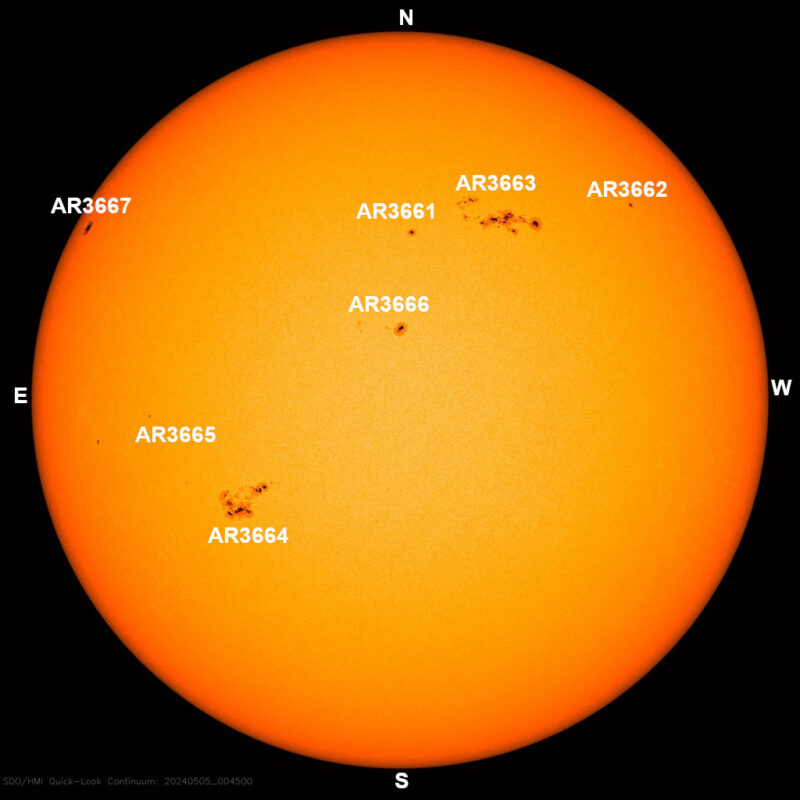
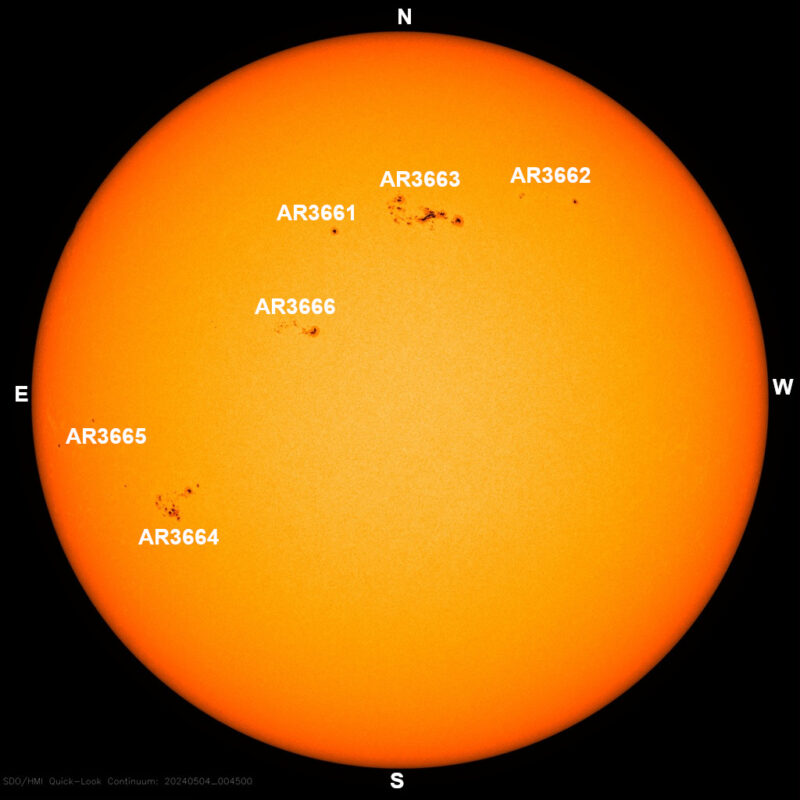
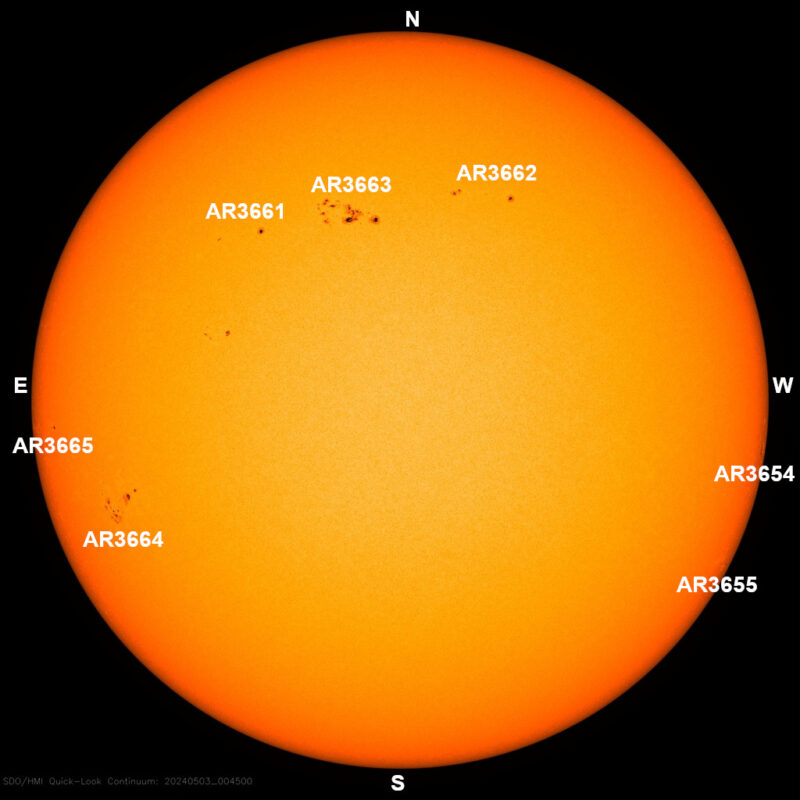
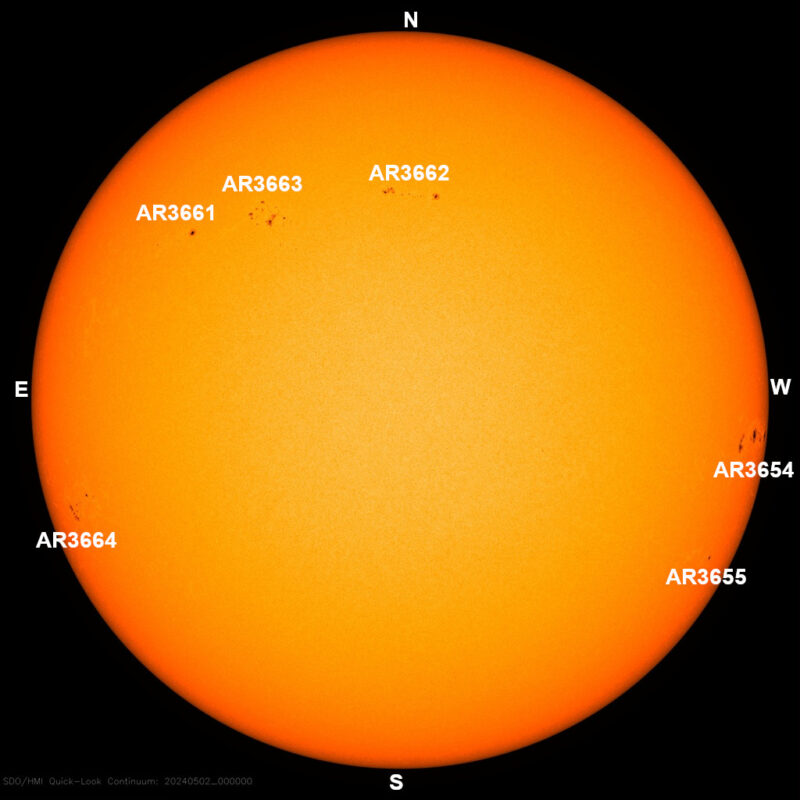
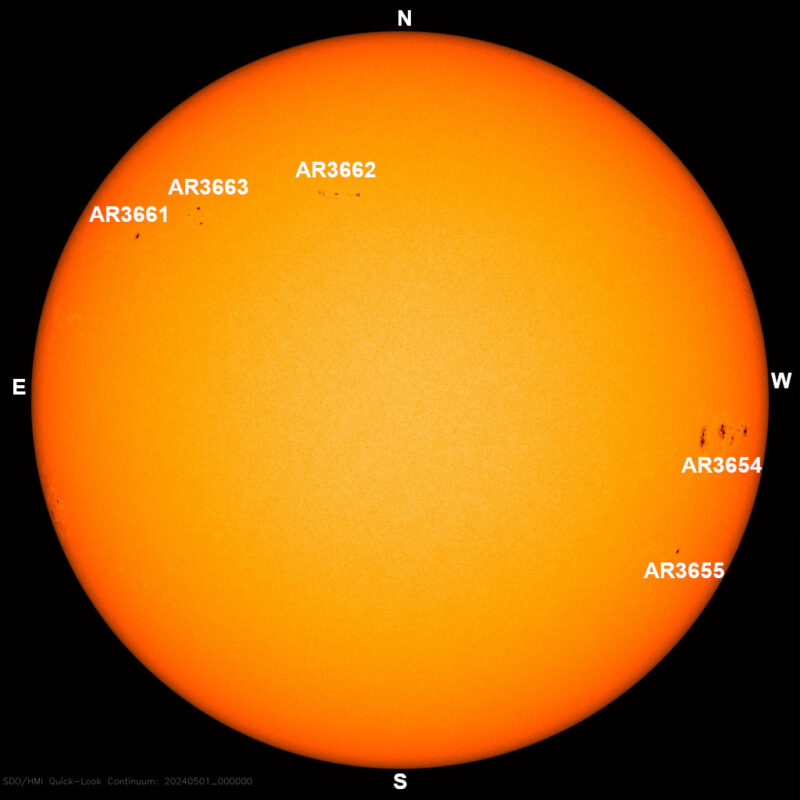
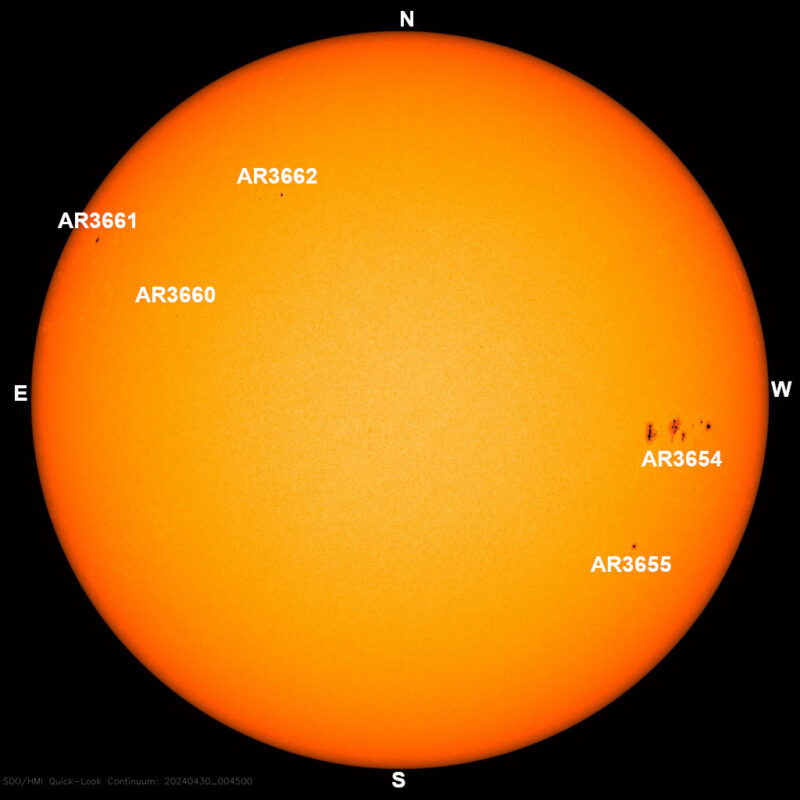
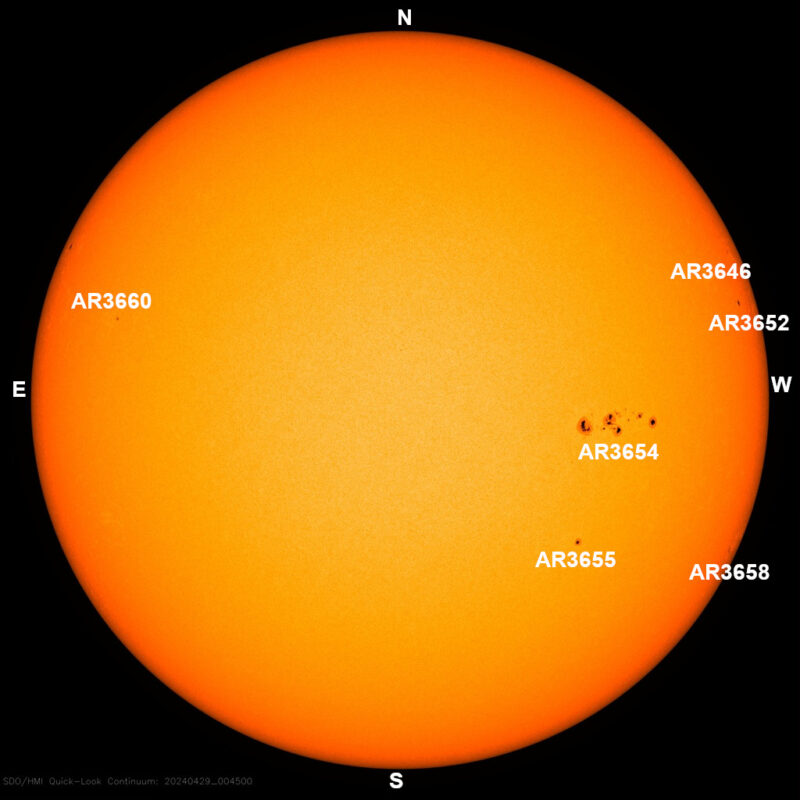
Sun images from our community
Are you a fan of sun images? We invite you all to send us your beautiful recent photos of sunspots and auroras. We love receiving them and sharing them! And to those of you who’ve already posted a photo to our community page, thank you.


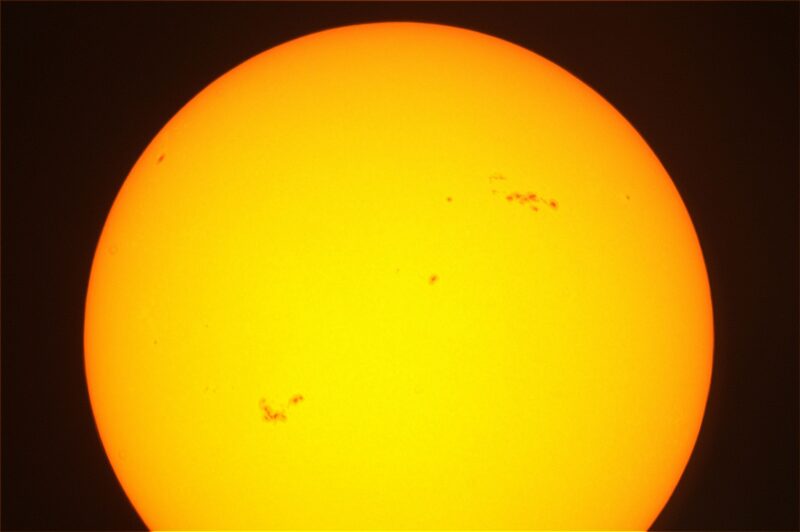
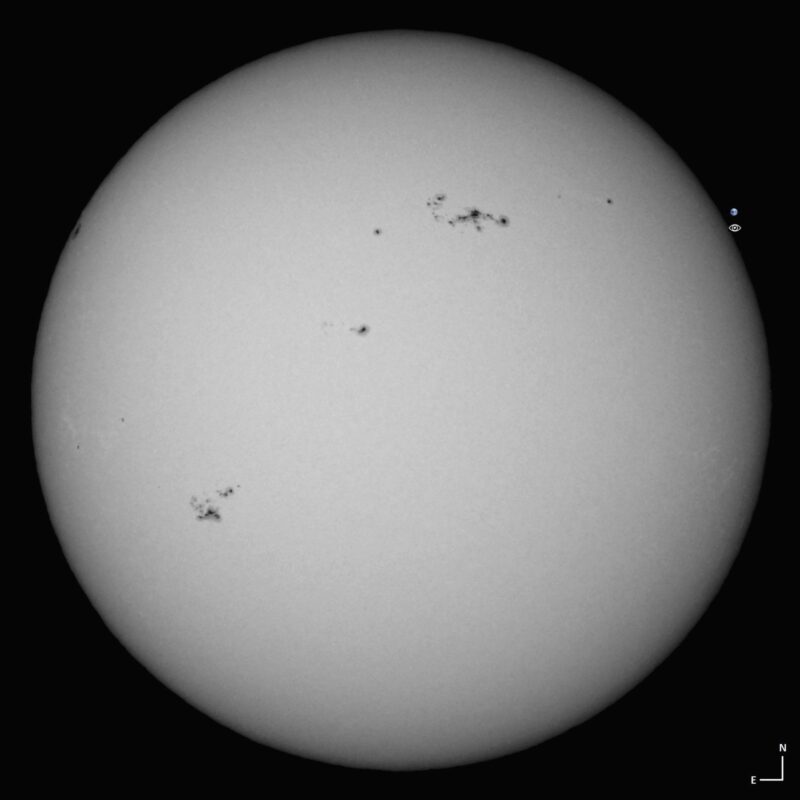
Bottom line: Sun news for May 5, 2024. X flare! AR3663 is flaring like crazy. It produced most of the flares during the day including an X flare, and two almost-X flares.











